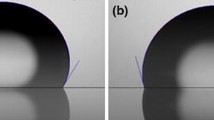Abstract
Stain patterns formed by drying up of droplets of polymer latex dispersion on hydrophilic and hydrophobic surfaces were examined in light of the mechanism of particle adsorption in evaporating droplets. On hydrophilic surfaces, the volume of droplets decreased with time, keeping the initial outline of contact area, and circular stain patterns were formed after the dry-up of droplets. By the microscopic observation of particles in the droplets, it was found that a large portion of the particles were forced to adsorb on the outline of the contact area where a microscopic thin water layer was formed because of hydrophilicity of the surface. On hydrophobic surfaces, on the other hand, the contact area of droplets decreased as evaporation proceeded, while no particle was adsorbed on the surface at the early stages. The particles in the droplets started to aggregate when the concentration of particles reached a critical value, and the aggregates adsorbed on the surface forming tiny spots after the dry-up. Time evolutions of contact angle, contact area and volume of the droplets were analyzed in light of differences in the adsorption mechanisms between hydrophilic and hydrophobic surfaces.
Similar content being viewed by others
Author information
Authors and Affiliations
Additional information
Received: 14 January 1998 Accepted: 1 May 1998
Rights and permissions
About this article
Cite this article
Uno, K., Hayashi, K., Hayashi, T. et al. Particle adsorption in evaporating droplets of polymer latex dispersions on hydrophilic and hydrophobic surfaces. Colloid Polym Sci 276, 810–815 (1998). https://doi.org/10.1007/s003960050314
Issue Date:
DOI: https://doi.org/10.1007/s003960050314



